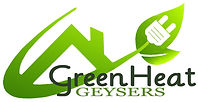Solar Geysers

Solar Water Heaters systems are designed to deliver hot water for most of the year.
However, in winter there sometimes may not be sufficient solar heat gain to deliver sufficient hot water.
In this case an electric booster (element or heat pump) is used to assist in heating the water to the required temperature of 55 degrees C, which is the optimal temperature.
The type, complexity, and size
of a solar water heating system are mostly determined by:
-
Changes in ambient temperature and solar radiation between summer and winter.
-
The changes in ambient temperature during the day-night cycle.
-
The possibility of the potable water or collector fluid overheating.
-
The possibility of the potable water or collector fluid freezing.
The minimum requirements of the system are typically determined by the amount or temperature of hot water required during winter, when a system's output and incoming water temperature are typically at their lowest.
Type of Solar Collectors:
Flat plate collectors:
-
They are an extension of the basic idea to place a collector in an 'oven'-like box with glass in the direction of the sun.
-
Most flat plate collectors have two horizontal pipes at the top and bottom, called headers, and many smaller vertical pipes connecting them, called risers. The risers are welded (or similarly connected) to thin absorber fins.
-
The type of glass used in flat plate collectors is almost always low-iron, tempered glass. Being tempered, the glass can withstand significant hail without breaking, which is one of the reasons that flat-plate collectors are considered the most durable collector type.
Evacuated tube collectors:
-
ETC are a way in which heat loss to the environment, inherent in flat plates, has been reduced.
-
Since heat loss due to convection cannot cross a vacuum, it forms an efficient isolation mechanism to keep heat inside the collector pipes.
-
Since two flat sheets of glass are normally not strong enough to withstand a vacuum, the vacuum is rather created between two concentric tubes.
-
Typically, the water piping in an ETC is therefore surrounded by two concentric tubes of glass with a vacuum in between that admits heat from the sun (to heat the pipe) but which limits heat loss back to the environment. The inner tube is coated with a thermal absorbent.
-
Life of the vacuum varies from collector to collector, anywhere from 5 years to 15 years.
Different types of High Pressure Solar Geysers Systems:
-
Thermo siphon systems:
Closed couple and split, both can be direct or indirect. Indirect means glycol (heat transferring liquid) is in the flat plate panel and not water. Indirect is recommended for frost areas as the glycol prevents the panel from freezing and bursting.
Closed couple means geyser and panel on roof.
Split means panel on roof outside, but lower than geyser in roof for the natural process of thermo siphoning to take place: The only moving “part” is the heat transferring liquid or glycol;
-
Pump system:
Geyser lower than panel and thermo siphon cannot work. 220V or 12V pump installed to circulate the water/glycol between the panel and geyser, as the natural process of thermo siphon will not take place.
-
Integrated system:
Evacuated tubes integrated with the geyser forming a unit. Geyser and evacuated tubes (collector/panel) on the roof;
-
Retrofit:
An evacuated tube collector or direct flat plate collector is retrofitted to your existing geyser or a new conventional electrical geyser. The retrofit also needs a pump to circulate the water between the geyser and collector.
The larger the storage vessel (geyser) of any solar geyser, the more electricity you will save as the solar panel/collector heats the water while the sun is shining. The more hot water you store, the less are the chances that the electrical backup element will kick in and/or the element will be on for a shorter time. This will save you electricity. Work on 50 to 70 litres per person on a geyser depending on life style and shower roses (use water saving roses of 9 lt per min instead of the normal roses that allow from 15lt and more per min).
Preferred brands of solar geysers installed by Greenergy Solutions :
We have access to various products on the market:






GreenHeat is proudly 100% locally manufactured for us
by a company manufacturing solar geysers,
with an excellent track record, since the previous century.
Indirect solar geyser in-house brand of Greenergy Solutions :
The features and benefits of the GreenHeat Indirect Geyser are:
-
It is better priced than most other indirect systems;
-
It carries a manufacturer’s warranty of 10 years;
-
To show our confidence in GreenHeat Indirect Geysers, Greenergy Solutions offers a maintenance contract for the first year - free of charge on any GreenHeat Indirect Geyser installed as a thermo siphoned system;
-
The GreenHeat Indirect Geyser is designed and manufactured for local conditions of the Highveld of Gauteng with it’s cold winters;
-
The geysers are manufactured of high quality stainless steel, which can handle extreme heat conditions, and a special welding method providing unmatched weld strength and quality ensuring a long and trouble free service;
-
The geysers are equipped with a double jacket type of heat exchanger enabling easy installation as an indirect system;
-
The panels are manufactured by using the advanced Blackfusion technology and latest prismatic glass technology.
